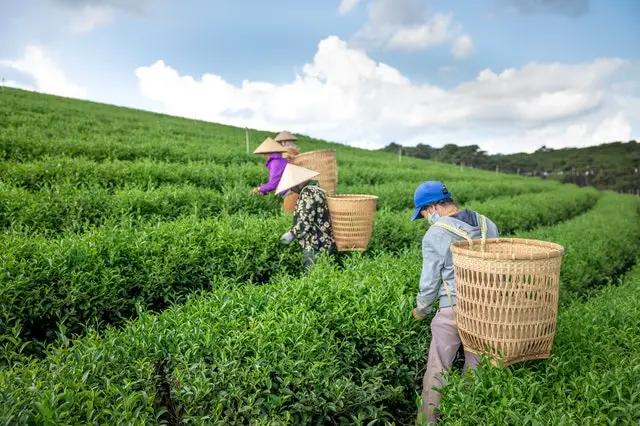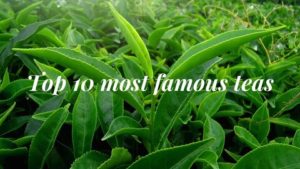What makes a tea ‘seasonal’?
The seasonality of the tea is an important aspect to consider when choosing which teas to buy. That’s because seasonality has an impact on quality (flavour and aroma), quantity and price.
Tea plants in certain countries or regions of a country are harvested all year around. That’s the case in places with a warm climate – tropical regions or those on/near the equator – countries in East Africa, Sri Lanka, Indonesia and Nilgiri in India. The climate makes the plant grow continuously. In general, it’s difficult to tell which plucks produce the best teas.
On the other hand, we have tea plants that are harvested from March until November – these produce the ‘seasonal’ teas. They grow in countries/regions with a more temperate climate – such as China, Japan, Darjeeling and Assam in India. Also, tea plants grown in the mountains are seasonal. Seasonal teas go through a dormant period during the winter months. That dormancy forces the plants to accumulate more nutrients from the soil. That helps tea masters to make exquisite, most healthful teas from the spring harvests.
Seasonality in key tea-producing countries
When deciding about the timing of their crops, farmers in many Asian countries use a solar calendar that follows the position of the sun relative to the earth. This calendar comprises 24 mini-seasons, each with its specific natural events.
In China, teas from the spring and autumn harvests are the most appreciated. The spring harvests are split into 4 plucks: pre-Qing Ming (before 5 April) – Qing Ming (5 April to 20 April) – Gu Yu (20 April to 6 May) – Lixia (6 May to 21 May). The autumn harvest is limited, mainly due to the intensive summer plucking.
The tea season in India (except for Nilgiri and Assam) and Nepal is broken down into ‘flushes’: first flush (early spring) – second flush (late spring to early summer) – monsoon flush (mid-summer to early fall) – autumnal flush. In Assam and Nilgiri, there is also a winter flush (December to March) which makes the best teas (called ‘frost teas’).
The harvest season in Japan is split into Shincha (early April) – Ichibancha (mid-May) – Nibancha (end of June) – Sanbancha (mid-August) – Yonbancha (late September).
In South Korea, the tea harvests are known as Ujeon (before the rain, around 20 April) – Sejak (small sparrow, around 6 May) – Jungjak (medium sparrow, around 21 May) – Daejak (large sparrow, summer plucking). The ‘sparrow’ refers to the tea buds that resemble the tongue of a sparrow.
As for Taiwan, it’s more difficult to establish the usual plucking times. That’s because Taiwanese tea plants grow at elevations that differ widely from one place to another. Also, the weather patterns differ greatly across regions.
In Sri Lanka, the best teas come from certain months; these ‘ideal’ months differ across regions. For example, the best teas from Nuwara Eliya region are made in February.
Spring harvests (March to May)
In general, the spring harvests are the most valuable, at least in China and Japan.
The most prized teas in China are those picked pre-Qing Ming. From this first harvest, tea masters make only green teas and white teas. The leaves to make the best Silver Needle are plucked for only a few days each year before mid-March.
The leaves plucked first time in the year are of better quality and fewer in quantity – which explains the high price tag. From later harvests, tea masters make oolong and black teas. One example of a delicious black tea made from the spring harvest is Yunnan Dian Hong Golden.
In Japan, the highest-grade Gyokuro, Sencha and Matcha are produced from the Shincha harvest.
Summer harvests (June to August)
The warm and rainy weather makes the tea plants grow very rapidly. The tea plucking reaches its most intensive period. The mass-produced teas as well as the teas used as the base for flavoured teas come from the summer harvests. The high quantity and lower quality (reduced aroma and flavour) can drop the price of these teas considerably.
But there is an outlier – Assam tea – the best tea comes from the summer harvest which occurs before the monsoon rain period. Tea lovers appreciate them for their rich and malty flavour.
Autumn harvests (September to November)
Chinese tea masters can make very good dark oolongs from these harvests. For instance, some people say that the most fragrant Wuyi Rock Oolong and Tie Guan Yin come from the September plucking. Also, some of the best Taiwanese oolongs are made from the late autumn harvest. The cooler temperature revives the flavour and aroma of the tea.
Final remarks
You can find out more about tea harvesting from the video below.
The seasonality of the tea I’m looking to buy is very important because it helps me choose a tea that I’ll enjoy. So, I recommend you look out for when the tea was made (the time of the year) the next time you want to try out a new tea.
Reference: The Tea Enthusiast’s Handbook, Mary Lou and Robert Heiss, 2010


